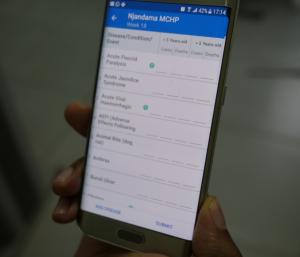Transforming disease surveillance through an electronic reporting platform in Sierra Leone
The Ministry of Health and Sanitation is in the process of migrating disease surveillance reporting from a cumbersome paper-based system to a web-based electronic platform (e-IDSR) for real-time information flows. The process is part of the revitalisation of disease surveillance and response in Sierra Leone supported by WHO in partnership with the US Centers for Disease Control (CDC) and e-Health Africa.
Managing surveillance data using paper-based tools has lots of limitations with high probabilities for errors, and potential health costs. In Sierra Leone it meant that there were challenges in submitting report with health workers sometimes having to travel far distances along difficult terrains to submit their files. This can impact on the health sector's ability to monitor and respond to health issues and events.
Alhaji Dauda Kamara heads the Mange Community Health Centre in Port Loko district where the e-IDSR pilot has taken place, and has now started using the electronic platform for routine reporting. He says that the new system has reduced time spent on reporting but also allowed staff at the facility to more readily access their data and track the health situation.
“We used to accumulate all these completed forms for hand delivery, which was very burdensome for us," he says. "We now do realtime reporting with ease using the electronic tool which is much more convenient, and has reduced the challenges we faced with submitting quality data. This marks a big improvement both for us and for the district,” he says.
After the training of health workers in 105 health facilities in Port Loko district, the Ministry of Health and Sanitation will now roll out the system to all health facilities in a phased manner, with gradual scale-up to the country's remaining 13 districts. Health workers will then be able to use the e-IDSR system to report surveillance data directly to the national level.
Integrated with the country’s District Health Information System (DHIS2), the electronic system has helped to improve the timeliness of reporting, reporting rates, data quality and efficiency, and eased data management by establishing a web-accessible data repository at the national level.



